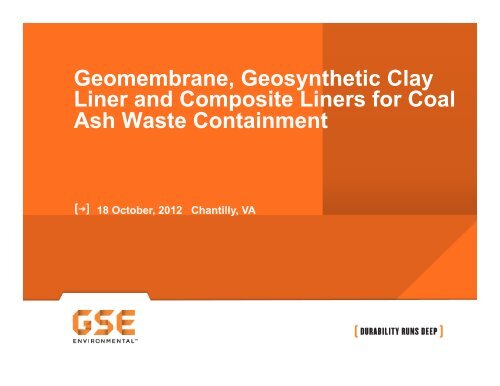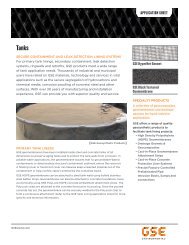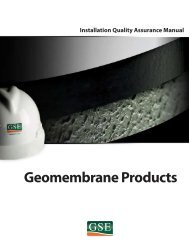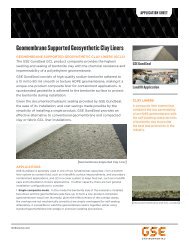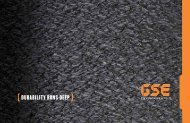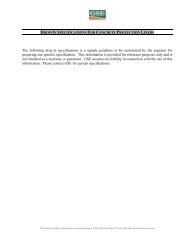Boyd Ramsey, GSE Chief Engineer
Boyd Ramsey, GSE Chief Engineer
Boyd Ramsey, GSE Chief Engineer
Create successful ePaper yourself
Turn your PDF publications into a flip-book with our unique Google optimized e-Paper software.
Geomembrane, Geosynthetic Clay<br />
Liner and Composite Liners for Coal<br />
Ash Waste Containment<br />
18 October, 2012 Chantilly, VA
Global Footprint<br />
2
Products<br />
Geomembranes<br />
Geomembranes are the most<br />
widely used products for solid<br />
waste containment (such as<br />
landfill liners), mining, and water<br />
containment applications.<br />
GeoSynthetic<br />
Clay Liners<br />
Geosynthetic clay liners (GCLs) combine<br />
geosynthetics with sodium bentonite clay<br />
to form a highly impermeable barrier that<br />
often replaces thick layers of expensive<br />
compacted clay.<br />
Geonets and<br />
Geocomposites<br />
<strong>GSE</strong> offers a broad range of quality<br />
geonet and geocomposite drainage<br />
liners designed to complement or<br />
replace sand, stone and gravel.<br />
Geotextiles<br />
<strong>GSE</strong> produces the most uniform,<br />
consistent and versatile nonwoven<br />
geotextile products on the market.<br />
Our products are available in many<br />
weights and thicknesses to meet your<br />
specific project requirements.<br />
Concrete Protection<br />
Protect your investments<br />
with <strong>GSE</strong> StudLiner, a line of high<br />
density polyethylene (HDPE) concrete<br />
protection products with studs on one<br />
side that lock the liner into the surface to<br />
prolong the life of the concrete.<br />
Specialty Products<br />
<strong>GSE</strong> has developed specialty products<br />
to provide for unique solutions. Whether<br />
it is for environmental, aquaculture, civil,<br />
tunnel or other demanding applications,<br />
<strong>GSE</strong> products are easy to install and<br />
built to last.<br />
3
About Us<br />
Success is always a collaborative effort<br />
• <strong>GSE</strong> offers the largest capacity and widest selection of<br />
smooth or textured polyethylene geomembranes in the<br />
industry.<br />
• No other manufacturer offers a broader line of specialty<br />
products to meet unique needs.<br />
• Several of our product lines were launched as a direct<br />
result of collaboration with our customers to help them<br />
solve complex problems.<br />
4
Geosynthetic Barrier Materials and Regulations<br />
needed.<br />
In December 2008 a<br />
levee containing coal<br />
ash failed at a TVA<br />
facility in Kingston TN.<br />
Subsequent clean-up<br />
costs are in excess of<br />
1.4 billion US dollars.<br />
5
Geosynthetic Barrier Materials Well-Recognized<br />
On 31 October 2011 a bluff on<br />
the We Energies Oak Creek<br />
power plant site collapsed,<br />
spilling coal ash into Lake<br />
Michigan<br />
On 1 March 2012 WDNR<br />
issued NOV<br />
“Lack of lining in pond blamed in<br />
bluff collapse at We Energies site” ..<br />
Milwaukee Journal Sentinel<br />
6
USEPA documented groundwater contamination<br />
sites (coal ash storage)<br />
7
Subtitle D liner system<br />
Leachate Removal System<br />
(i.e. perforated pipe network)<br />
≥ 12”<br />
≥ 24”<br />
Solid Waste<br />
Filter Layer<br />
Permeability ≥1x10 -2 cm/sec<br />
Permeability ≤1x10 -7 cm/sec<br />
Soil Subgrade<br />
EPA Minimum<br />
Technical Guidance<br />
Leachate Collection<br />
Geomembrane ≥ 30 mils<br />
if HDPE then ≥ 60 mils<br />
Compacted Clay Liner (CCL)<br />
8
Subtitle D cover system<br />
≥ 6”<br />
≥ 18”<br />
Top Soil<br />
Permeability<br />
k ≤ bottom liner ≤ 1x10 -5 cm/sec<br />
Gas Vent (if necessary)<br />
Solid Waste<br />
Geomembrane ≥ 20 mils<br />
if HDPE, ≥ 40 mils is most common<br />
Compacted Clay Liner (CCL)<br />
EPA Minimum<br />
Technical Guidance<br />
9
Geosynthetic Clay Liners (GCLs)<br />
GM<br />
GM/CCL<br />
GM/GCL<br />
“Leak detection system flow rates attributable to<br />
leakage through GM/CCL and GM/GCL/CCL primary<br />
liners constructed with CQA are probably similar to<br />
those for GM/GCL primary liners constructed with<br />
CQA.”
HIGH<br />
PERFORMANCE<br />
GEOMEMBRANE
Differentiation<br />
Best<br />
Better<br />
Good<br />
High Performance<br />
Industry Standard<br />
Products<br />
Purpose-driven<br />
Products<br />
13<br />
13
What must a High Performance geomembrane do?<br />
Last longer<br />
More durable<br />
14
What must a High Performance geomembrane do?<br />
Break Elongation<br />
Multi-axial Break Resistance<br />
High Pressure Oxidative Induction Time (HPOIT)<br />
HPOIT Retention<br />
UV Resilience<br />
Environmental Stress Crack Resistance<br />
15
How?<br />
Raw material selection<br />
Resin<br />
Additives<br />
Carbon Black<br />
16
Selecting the Right Resin<br />
Break Elongation<br />
Multi-axial Resistance<br />
Stress Crack Resistance<br />
17
HPOIT (minutes)<br />
Selecting the Right Additives<br />
High Density:<br />
Linear Low Density:<br />
+100% +38%<br />
HPOIT (minutes)<br />
18
Selecting the Right Additives<br />
Oven Aging<br />
High Density:<br />
+100%<br />
Linear Low Density:<br />
+83%<br />
19
Selecting the Right Additives<br />
UV Aging<br />
High Density:<br />
+220%<br />
Linear Low Density:<br />
+214%<br />
20
Multi-axial Performance<br />
True performance test<br />
Differential settlement causes at<br />
least 20%<br />
Defects and flaws can cause<br />
poor performance<br />
Structured geomembranes<br />
struggle<br />
21
High Pressure Oxidative Induction Time<br />
Measures additives active at<br />
field conditions<br />
Why?<br />
The test operates at a lower<br />
temperature<br />
A temperature where the<br />
additives are active<br />
22
What is Leak Location Geomembrane Liner?<br />
• Co-extrusion Process – allows for variety of surface layers<br />
– Textured or Smooth<br />
– Black, White, Green, and Conductive:<br />
Example: 1.5 mm <strong>GSE</strong> Conductive White Geomembrane<br />
White ≈ 0.13 mm<br />
Standard Black ≈ 1.32 mm<br />
Conductive ≈ .08 mm<br />
3
SKB Lansing Landfill Project<br />
24
SKB Lansing Landfill Project<br />
25
SKB Lansing Landfill Project<br />
26
SKB Lansing Landfill Project<br />
27
SKB Lansing Landfill Project<br />
28
APPLICATIONS<br />
29
Landfill Closures<br />
30
Mining<br />
31
Exposed Applications<br />
32
Hazardous Waste<br />
33
Tunnels<br />
34
Harsh Conditions<br />
35
<strong>GSE</strong> COAL ASH<br />
RESISTANT GCL
Coal Ash Leak Location Liner System<br />
<strong>GSE</strong> Coal Ash Drain Geocomposite<br />
(Reduces or replaces aggregate leachate<br />
collection layer and graded filter)<br />
<strong>GSE</strong> Leak Location Liner<br />
(Spark testable geomembrane)<br />
<strong>GSE</strong> Coal Ash Resistant GCL<br />
(Polymer enhanced geosynthetic clay liner)
Geosynthetic Clay Liners (GCLs)<br />
• Consistent Low Permeability<br />
Hydraulic Barrier<br />
• Superior Performance Alternative<br />
to Compacted Clay Liner<br />
• Protects Geomembrane from<br />
Puncture<br />
• Reduced Installation Cost and<br />
Time<br />
• Saves Airspace<br />
• Self-Sealing Properties<br />
38
GCL Hydraulic Conductivity<br />
• Unlike compacted clays, GCL<br />
permeability varies with effective stress.<br />
• The greater the effective stress (load)<br />
the lower the GCL’s permeability.<br />
• Can vary as much as 10X in landfill<br />
bottom liners, i.e. as constructed to final<br />
fill.<br />
• Hydraulic Conductivity<br />
‒ ASTM D5887<br />
‒ Effective Confining Stress is 5 psi<br />
‒ Typical Value is 3 x 10 -9 cm/sec<br />
* Petrov, R.J. et al (1997) “Equations for Calculating the Rate of Liquid Migration Through Composite Liners Due to Geomembrane Defects”.<br />
39
Compacted Clay Liners (CCLs)<br />
75 Feet<br />
1 x 10 -5 cm/s = 4% of area and 50.3% of flow<br />
1 x 10 -7 cm/s = 31% of area and 3.6% of flow<br />
1 x 10 -8 cm/s = 25% of area and 0.3% of flow<br />
• 10,000x range of permeability values.<br />
30<br />
Feet<br />
1 x 10 -6 cm/s = 40% of area and 45.8% of flow<br />
• Much of the test area failed to meet 1 x 10 -7 cm/sec requirement.<br />
Rogowski, 1990<br />
40
“Assessment and Recommendations for<br />
Improving the Performance of Waste<br />
Containment Systems”,<br />
R. Bonaparte, D.E. Daniel, and R.M. Koerner,<br />
EPA/600/R-02/099,<br />
http://www.epa.gov/nrmrl/pubs/600r02099.pdf<br />
41
Compacted Clay Liners - Objectives<br />
• Measure in-situ Performance<br />
• Focus – Hydraulic Conductivity<br />
• Design & Construction Variables –<br />
Determine impacts<br />
• Meeting Regulatory Requirements?<br />
• Meeting Design Objectives?<br />
• Cover Applications<br />
• Document Performance<br />
• Survivability<br />
• Settlement Impact<br />
42
Compacted Clay Liners - Findings<br />
• 89 CCL Sites<br />
• Specified – 1 x 10E-7 cm/s<br />
• 25% Failed.<br />
• Why? – Failure to compact within<br />
the specified moisture zone and<br />
dry density.<br />
• Cover Failure – Desiccation<br />
occurs without GM liner and low<br />
Hydraulic Conductivity is lost<br />
within a few years of placement.<br />
43
Geosynthetic Clay Liners (GCLs)<br />
GM<br />
GM/CCL<br />
GM/GCL<br />
“Leak detection system flow rates attributable to<br />
leakage through GM/CCL and GM/GCL/CCL primary<br />
liners constructed with CQA are probably similar to<br />
those for GM/GCL primary liners constructed with<br />
CQA.”
Geosynthetic Clay Liners – Advantages<br />
• Self-healing Properties<br />
• Superior Hydraulic Conductivity to CCLs<br />
• Low Material & Installation Costs<br />
• Quick & Easy Installation<br />
• Low Volume Occupied Relative to CCLs<br />
• Withstand Differential Settlement<br />
• Self-heal After Desiccation<br />
• Resistance to Damaging Freeze/Thaw<br />
Effects<br />
45
Geosynthetic Clay Liners – Disadvantages<br />
• Bentonite Chemical Alterations –<br />
• Free available Calcium & Magnesium<br />
• Low Overburden Stresses<br />
• Final Cover Systems<br />
• Slope Stability When Hydrated<br />
• Low Bentonite Hydrated Shear Strength<br />
• Internal reinforcement<br />
• Peel Strength<br />
• Thickness<br />
• ~10 mm Thick<br />
• Vulnerable to puncture<br />
46
GCL Product Types<br />
Sodium bentonite<br />
Sodium bentonite<br />
<strong>GSE</strong> BentoLiner - Fabric Encased GCL<br />
Nonwoven geotextile<br />
Woven or nonwoven<br />
geotextile<br />
<strong>GSE</strong> GundSeal - Geomembrane Supported GCL<br />
Geomembrane<br />
Giroud Leakage Equation and Contact Factor-C:<br />
Q GM = C [1 + 0.1(h w / t) 0.95 ] a 0.1 h w 0.9 ks 0.74<br />
Where C varies from 0.01 (excellent) to 1.15 (poor contact)<br />
47
Geomembrane Supported GCL<br />
• Provides swelling and sealing of bentonite clay with the chemical resistance and<br />
impermeability of HDPE geomembrane<br />
• 15 mil to 80 mil smooth or textured geomembrane<br />
• Installed in a single composite mode or encapsulated mode<br />
Geomembrane<br />
Sodium Bentonite<br />
Spunbonded Geotextile
Contact Factor<br />
Geotextile Encased GCL: Relative Good Hydraulic Contact<br />
<strong>GSE</strong> GundSeal: Bentonite Side Down, Excellent Hydraulic Contact<br />
Giroud Leakage Equation and Contact Factor-C:<br />
Q GM = C [1 + 0.1(h w / t) 0.95 ] a 0.1 h w 0.9 ks 0.74<br />
Where C varies from 0.01 (excellent) to 1.15 (poor contact)
Encapsulated Mode<br />
• Two product installation<br />
• Accepted U.S. and International liner system since 1991<br />
• Improved leakage performance over geomembrane/CCL liner<br />
• Improved slope performance<br />
• Prevents bentonite prehydration
GCL Product Types<br />
Sodium bentonite<br />
Sodium bentonite<br />
<strong>GSE</strong> BentoLiner - Fabric Encased GCL<br />
Nonwoven geotextile<br />
Woven or nonwoven<br />
geotextile<br />
<strong>GSE</strong> GundSeal - Geomembrane Supported GCL<br />
Geomembrane<br />
51
Geosynthetic Clay Liners (GCLs)<br />
<strong>GSE</strong> BentoLiner<br />
Fabric Encased GCL
Fabric Encased GCL<br />
Sodium bentonite<br />
Nonwoven geotextile<br />
Woven or nonwoven<br />
geotextile<br />
<strong>GSE</strong> BentoLiner Geosynthetic Clay Liner Product Options<br />
1. EC – woven & 3 oz/SY non-woven<br />
2. NSL – woven & 6 oz non-woven geotextiles<br />
3. CNSL – nominal 5 mil thick PP-coated NSL<br />
4. LNSL – 3 mil HD geo-film laminated onto NSL<br />
5. NWLL – 3 oz scrim non-woven & 6 oz woven geotextiles<br />
6. NWL – one 6 oz non-woven and one 6 oz scrim nonwoven geotextile<br />
53
BentoLiner Fabric Encased GCL<br />
• High Quality Wyoming Sodium Bentonite<br />
‒ High Free Swell<br />
‒ Low Fluid Loss<br />
• Manufacturing<br />
• Integral Scrim Reinforced – Inhibits panel shrinkage<br />
and seam separation<br />
• “Needle Free” Product<br />
• Shipping – High square footage per truck/container<br />
(~39,525 SF, 3,850 SM)
Coal Ash Resistant GCL<br />
<strong>GSE</strong> Polymer Enhanced Coal Ash Resistant GCL<br />
• High Quality Wyoming Sodium Bentonite<br />
‒ High Free Swell<br />
‒ Low Fluid Loss<br />
• Blended with Proprietary Long Chain Polymers<br />
‒ Expanding of the polymers reduces the space for water to travel<br />
around the sodium bentonite platelets<br />
‒ The polymers absorb components responsible for cation<br />
exchange, allowing fresh water to hydrate the sodium bentonite<br />
‒ Polymers are currently used in NSF Certified applications
Leachate Analysis with High Ionic Strength<br />
Acid Mine<br />
Drainage<br />
Solution 1<br />
Coal Ash<br />
Leachate<br />
Solution 2<br />
Cations mg/L mg/L<br />
Gypsum<br />
Leachate<br />
Solution 3<br />
Fly Ash/<br />
FGD<br />
Leachate<br />
Solution 4<br />
Fly Ash/<br />
Gypsum<br />
Leachate<br />
Solution 5<br />
mg/L mg/L mg/L<br />
Calcium 660 820 580 740 480<br />
Magnesium 4,000 340 220 6 530<br />
Potassium 660 30 14 410 93<br />
Sodium 670 82 78 240 2200<br />
Anions<br />
Chloride 8,600 1,300 250 1,200 980<br />
Sulfate 10,000 1,900 2,200 1,600 7600<br />
56
Solution 1 – Acid Mine Drainage<br />
Hydraulic Conductivity (cm/sec)<br />
1.00E-06<br />
1.00E-07<br />
1.00E-08<br />
1.00E-09<br />
1.00E-10<br />
1 6 11 16 21 26 31 36 41 46 51 56 61 66 71 76 81 86 91 96 101 106 111 116 121 126 131 136 141 146 151 156 161 166 171<br />
≈ 8 Pore Volumes (Standard Bentonite)<br />
≈ 7 Pore Volumes<br />
(CAR GCL)<br />
Days<br />
≈ 13 Pore Volumes<br />
(CAR GCL)<br />
Solution 1 (10% Moisture) Solution 1 (50% Moisture) Solution 1 (std. bentonite)<br />
57
Solution 2 – Coal Ash Landfill<br />
Hydraulic Conductivity (cm/sec)<br />
1.00E-06<br />
1.00E-07<br />
1.00E-08<br />
1.00E-09<br />
1 6 11 16 21 26<br />
Days<br />
Solution 2 (50% Moisture)<br />
≈ 4 Pore Volumes<br />
58
Solution 3 – Gypsum Leachate<br />
Hydraulic Conductivity (cm/sec)<br />
1.00E-06<br />
1.00E-07<br />
1.00E-08<br />
1.00E-09<br />
Days<br />
1 6 11 16 21 26 31 36 41 46 51 56 61 66 71 76 81 86 91 96 101 106 111 116<br />
≈ 1.21E-07 cm/sec<br />
≈ 70 Pore Volumes<br />
≈ 22 Pore Volumes<br />
Solution 3 BentoLiner CAR (10% Moisture) Solution 3 BentoLiner Std (10% Moisture)<br />
59
Solution 4 – Fly Ash/FGD Leachate<br />
Hydraulic Conductivity (cm/sec)<br />
1.00E-06<br />
1.00E-07<br />
1.00E-08<br />
1.00E-09<br />
1.00E-10<br />
Days<br />
1 6 11 16 21 26 31 36 41 46 51 56 61 66 71 76 81 86 91 96 101 106 111 116<br />
≈ 23 Pore Volumes<br />
≈ 11 Pore Volumes<br />
Solution 4 BentoLiner Std (10% Moisture) Solution 4 BentoLiner CAR (10% Moisture)<br />
60
Solution 5 – Fly Ash/Gypsum Leachate<br />
Hydraulic Conductivity (cm/sec)<br />
1.00E-06<br />
1.00E-07<br />
1.00E-08<br />
1.00E-09<br />
1.00E-10<br />
Days<br />
1 6 11 16 21 26 31 36 41 46 51 56 61 66 71 76 81 86 91 96 101 106 111 116<br />
≈ 11 Pore Volumes<br />
≈ 8 Pore Volumes<br />
Solution 5 BentoLiner Std (10% Moisture) Solution 5 BentoLiner CAR (10% Moisture)<br />
61
Resources<br />
Depending on soil size and<br />
overburden loads, many products<br />
offered by <strong>GSE</strong> can be selected<br />
for geomembrane use and<br />
protection.<br />
A step-by-step design method is<br />
provided in this <strong>GSE</strong> Design<br />
Manual.<br />
62
Resources<br />
Product selection for <strong>GSE</strong>’s GCL<br />
product lines with step-by-step<br />
design method is provided in this<br />
<strong>GSE</strong> GCL Design Manual.<br />
A section on GCL/CCL<br />
equivalency is included.<br />
63
Resources<br />
Product selection for<br />
<strong>GSE</strong>’s Drainage product<br />
lines with step-by-step<br />
design methods and<br />
performance calculations<br />
is provided.<br />
Also available on line for iterative design work.<br />
www.gseworld.com<br />
64


